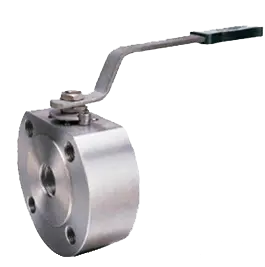
Differences in Structural Design
The valve body of the wafer ball valve is designed as a clamp type, meaning the valve is clamped between two sections of pipeline using bolts, eliminating the additional space required by traditional flange connections. Its compact structure, small space requirement for installation, and light weight make it suitable for pipeline systems with limited space.
Conventional ball valves are generally either flanged or threaded. Flanged ball valves have flanges at both ends of the valve body, which are bolted to the pipeline flanges. Threaded ball valves, on the other hand, connect to the pipeline via threads. Compared to wafer ball valves, flanged and threaded ball valves have larger and heavier structures, occupying more space.
Differences in Installation Methods
Installation of wafer ball valves is simple and quick; the valve is clamped between the pipelines and secured with bolts. This design significantly simplifies the installation steps of the valve, saving installation time and costs.
For ordinary ball valves: Flanged ball valves require aligning the valve with the pipeline flange and securing it with bolts, making the installation process more complex. Threaded ball valves require screwing the valve into the pipeline threads, which is also relatively complex. Compared to wafer ball valves, the installation time and costs of ordinary ball valves are higher.
Differences in Maintenance and Repair
Maintenance and inspection of wafer ball valves are very convenient; simply loosening the bolts allows the valve to be removed from the pipeline for examination and maintenance. Its simple structure and fewer components make disassembly and assembly easy.
In contrast, maintenance and inspection of ordinary ball valves are relatively complex, especially for flanged ball valves, which require removing bolts and flanges, making the process cumbersome. Threaded ball valves also require certain skills and tools for disassembly and assembly, resulting in higher maintenance costs.
Differences in Application Scenarios
Wafer ball valves, due to their compact structure, lightweight, and easy installation, are suitable for pipeline systems with limited space and widely used in municipal water treatment, chemical, pharmaceutical, food industries, and other sectors. They are particularly applicable in situations requiring frequent maintenance and inspection.
On the other hand, ordinary ball valves are known for their robust structure and excellent sealing performance, making them suitable for various industrial pipeline systems, especially in applications requiring high pressure, high temperature, and large flow control. Flanged ball valves are commonly used in industries such as oil and gas, chemical, and power generation, owing to their superior sealing performance and strength. Threaded ball valves, on the other hand, are predominantly used in small-diameter pipeline systems, such as residential and plumbing applications.
Differences in Costs
The manufacturing cost of wafer ball valves is relatively low due to the elimination of flange and bolt connection parts, resulting in lower material and processing costs. Its installation and maintenance costs are also lower, making it suitable for projects with limited budgets.
Conversely, the manufacturing cost of ordinary ball valves, especially flanged ball valves, is relatively high because they require more materials and machining processes. Their installation and maintenance costs are also higher. However, their excellent sealing performance and strength meet the high requirements of industrial conditions.
